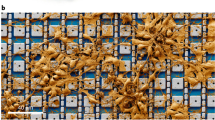Abstract
The detection of extracellular potentials in nervous tissue with conventional microelectrodes has many limitations. The number of sites at which activity can be detected in one experiment is small, and the noise performance of the system is frequently poor. A monolithic integrated circuit array of microelectrodes and buffer amplifiers has been built, enabling potentials to be detected simultaneously at nine sites, and substantially reducing the noise caused by electrostatic pick-up. The electrodes and buffer amplifiers were made on a silicon substrate using a fabrication process based on standard i.c. processing techniques. With an off-chip multiplexer, the potentials at each electrode have been displayed simultaneously on a normal oscilloscope in experiments on slices of rat brain tissue. Initial results have shown that an informative display which would be almost impossible to obtain with conventional electrodes can readily be produced, and that the long-term stability of the device is good.
Similar content being viewed by others
References
Bergveld, P. (1968) A new amplification method for in depth recording,IEEE Trans BME-15, 102–105.
Cobbold, R. S. C. (1970)Theory and applications of field effect transistors, Wiley Interscience, New York.
Glaser, A. B. andSubak-Sharpe, G. E. (1977)Integrated circuit engineering: design, fabrication and applications, Addison-Wesley, Massachusetts.
Haas, H. L., Schaerer, B. andVomansky, M. (1979) A simple perfusion chamber for the study of nervous tissue slicesin vitro, J. Neuroscience Methods,1, 323–325.
Hamilton, D. J. andHoward W. G. (1975)Basic integrated circuit engineering, McGraw-Hill, New York.
Jobling, D. T., Wheal, H. V. andSmith, J. G. (1980) Multiple extracellular recordings from the hippocampusin vitro. Demonstration to the Physiological Society, Oxford, 7 June 1980,J. Physiol. (Lond.). In Press.
Jobling, D. T. (1981) An active microelectrode array to detect extracellular nervous activity. PhD thesis, Department of Electronics, University of Southampton, England.
Lomo, T. (1971) Patterns of activation in a monosynaptic cortical pathway: The perforant path input to the dentrate area of the hippocampal formation,Exp. Brain Res.,12, 18–45.
Pickard, R. S. (1979a) Printed circuit microelectrodes.Trends in neurosciences, October 1979, 259–261.
Pickard, R. S. (1979b) A review of printed circuit microelectrodes and their production.J. Neuroscience Methods,1, 301–318.
Pollack, V. (1974) Impedance measurements on metal needle electrodes.Med. Biol. Eng.,12, 606–612.
Richman, P. (1973). MOS field effect transistors and integrated circuits, Wiley Interscience, New York.
Wise, K. D. andAngell, J. B. (1975) A low capacitance multielectrode probe for use in extracellular neurophysiology,IEEE Trans.,BME-22, 212–219.
Author information
Authors and Affiliations
Rights and permissions
About this article
Cite this article
Jobling, D.T., Smith, J.G. & Wheal, H.V. Active microelectrode array to record from the mammalian central nervous systemin vitro . Med. Biol. Eng. Comput. 19, 553–560 (1981). https://doi.org/10.1007/BF02442768
Received:
Accepted:
Issue Date:
DOI: https://doi.org/10.1007/BF02442768




